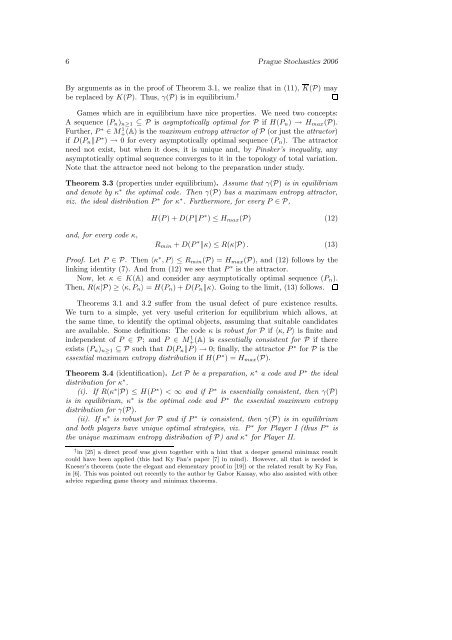Between Truth and Description
Between Truth and Description
Between Truth and Description
Create successful ePaper yourself
Turn your PDF publications into a flip-book with our unique Google optimized e-Paper software.
6 Prague Stochastics 2006<br />
By arguments as in the proof of Theorem 3.1, we realize that in (11), K(P) may<br />
be replaced by K(P). Thus, γ(P) is in equilibrium. †<br />
Games which are in equilibrium have nice properties. We need two concepts:<br />
A sequence (Pn)n≥1 ⊆ P is asymptotically optimal for P if H(Pn) → Hmax(P).<br />
Further, P ∗ ∈ M 1 +(A) is the maximum entropy attractor of P (or just the attractor)<br />
if D(Pn�P ∗ ) → 0 for every asymptotically optimal sequence (Pn). The attractor<br />
need not exist, but when it does, it is unique <strong>and</strong>, by Pinsker’s inequality, any<br />
asymptotically optimal sequence converges to it in the topology of total variation.<br />
Note that the attractor need not belong to the preparation under study.<br />
Theorem 3.3 (properties under equilibrium). Assume that γ(P) is in equilibrium<br />
<strong>and</strong> denote by κ ∗ the optimal code. Then γ(P) has a maximum entropy attractor,<br />
viz. the ideal distribution P ∗ for κ ∗ . Furthermore, for every P ∈ P,<br />
<strong>and</strong>, for every code κ,<br />
H(P ) + D(P �P ∗ ) ≤ Hmax(P) (12)<br />
Rmin + D(P ∗ �κ) ≤ R(κ|P) . (13)<br />
Proof. Let P ∈ P. Then 〈κ ∗ , P 〉 ≤ Rmin(P) = Hmax(P), <strong>and</strong> (12) follows by the<br />
linking identity (7). And from (12) we see that P ∗ is the attractor.<br />
Now, let κ ∈ K(A) <strong>and</strong> consider any asymptotically optimal sequence (Pn).<br />
Then, R(κ|P) ≥ 〈κ, Pn〉 = H(Pn) + D(Pn�κ). Going to the limit, (13) follows.<br />
Theorems 3.1 <strong>and</strong> 3.2 suffer from the usual defect of pure existence results.<br />
We turn to a simple, yet very useful criterion for equilibrium which allows, at<br />
the same time, to identify the optimal objects, assuming that suitable c<strong>and</strong>idates<br />
are available. Some definitions: The code κ is robust for P if 〈κ, P 〉 is finite <strong>and</strong><br />
independent of P ∈ P; <strong>and</strong> P ∈ M 1 + (A) is essentially consistent for P if there<br />
exists (Pn)n≥1 ⊆ P such that D(Pn�P ) → 0; finally, the attractor P ∗ for P is the<br />
essential maximum entropy distribution if H(P ∗ ) = Hmax(P).<br />
Theorem 3.4 (identification). Let P be a preparation, κ ∗ a code <strong>and</strong> P ∗ the ideal<br />
distribution for κ ∗ .<br />
(i). If R(κ ∗ |P) ≤ H(P ∗ ) < ∞ <strong>and</strong> if P ∗ is essentially consistent, then γ(P)<br />
is in equilibrium, κ ∗ is the optimal code <strong>and</strong> P ∗ the essential maximum entropy<br />
distribution for γ(P).<br />
(ii). If κ ∗ is robust for P <strong>and</strong> if P ∗ is consistent, then γ(P) is in equilibrium<br />
<strong>and</strong> both players have unique optimal strategies, viz. P ∗ for Player I (thus P ∗ is<br />
the unique maximum entropy distribution of P) <strong>and</strong> κ ∗ for Player II.<br />
† in [25] a direct proof was given together with a hint that a deeper general minimax result<br />
could have been applied (this had Ky Fan’s paper [7] in mind). However, all that is needed is<br />
Kneser’s theorem (note the elegant <strong>and</strong> elementary proof in [19]) or the related result by Ky Fan,<br />
in [6]. This was pointed out recently to the author by Gabor Kassay, who also assisted with other<br />
advice regarding game theory <strong>and</strong> minimax theorems.

















